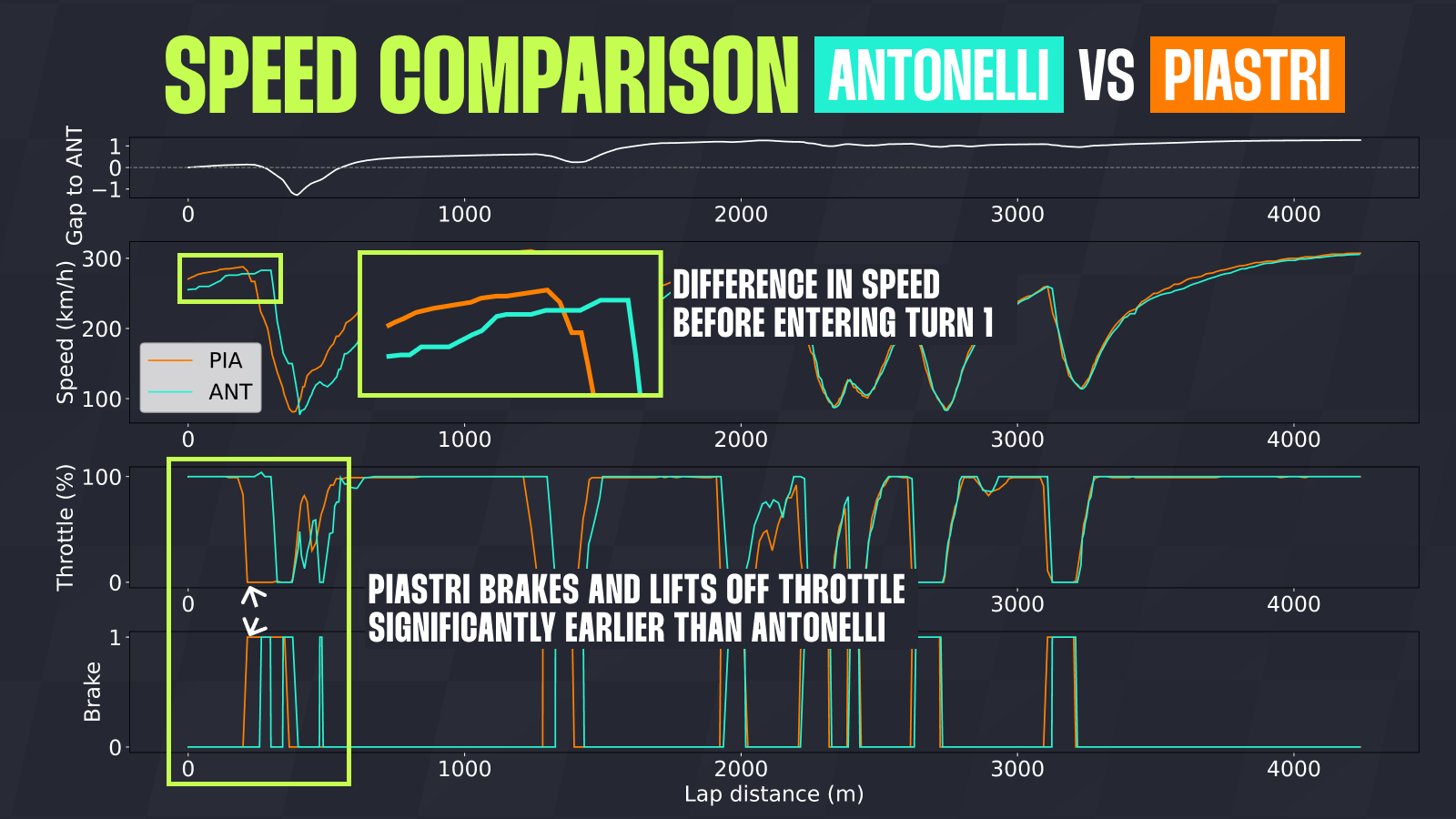A new angle on Oscar Piastri vs Kimi Antonelli: Was his penalty deserved?

Oscar Piastri was handed a 10-second penalty in Brazil.
After a sprint race to forget on Saturday, Oscar Piastri failed to redeem himself on Sunday and close the gap to his team-mate, who currently leads the championship.
That was largely due to the 10-second penalty Piastri received following his collision with Kimi Antonelli. To answer the question of whether this crucial FIA decision was justified, telemetry data helps shed some light.
Was Oscar Piastri’s penalty a turning point in the championship?
As mentioned, Piastri’s weekend didn’t begin the way he would have wanted. After being slower than Lando Norris in both FP1 and the sprint qualifying session, a small mistake in the sprint race itself proved extremely costly for his title hopes.
At a stage of the season where every point matters, losing eight points in the sprint was a significant blow and undoubtedly increased the pressure on the Australian.
Still, the main race on Sunday remained the key opportunity to recover and reduce the points gap. Piastri appeared on track to do exactly that — until the FIA decided to hand him a 10-second penalty for causing a collision.
More post-race analysis from the Sao Paulo Grand Prix
👉 Brazil GP conclusions: Key Norris change, Max’s big fight, latest Piastri SOS, new Ferrari solution
👉 Brazilian Grand Prix driver ratings: Verstappen breaks the scale; Hamilton horror
So let’s look deeper into this incident and see whether the FIA stewards really made the right call.
It all began with a poor restart from Antonelli after the VSC period on lap 6. Despite being on softer soft tyres than the cars around him, the young Italian lost rear traction when applying the throttle, forcing him to momentarily lift off. This cost him momentum — something Piastri immediately took advantage of, using the slipstream to draw almost wheel-to-wheel with him.

With a significantly higher top speed before the entry to Turn 1, it was perfectly reasonable for Piastri to attempt an overtake. He was positioned on the inside line, though still slightly behind Antonelli’s car.
At that moment, Antonelli drifted gently left, leaving Piastri no room. The McLaren driver braked in an attempt to avoid contact, which led to a lock-up of the front-left tyre and light contact between the two. Antonelli’s car was then pushed into Charles Leclerc, who came off worst — the only one of the three forced to retire as a result.
Telemetry shows just how much higher Piastri’s entry speed was into Turn 1, and how much earlier he was forced to brake compared to Antonelli.

The FIA’s official reasoning stated that Piastri was unable to sufficiently slow down and therefore caused the collision with Antonelli. However, when examining the footage more closely, a different perspective emerges.
At the moment of contact, Piastri’s front-left wheel was already off the track, and he was forced even further left immediately afterwards. Given Antonelli’s trajectory, avoiding contact was nearly impossible. It’s also worth noting that up until the apex of Turn 1, the protective barrier runs very close to the left-hand side of the track, leaving little margin for escape.
Another interesting detail becomes clear when comparing Piastri’s throttle and brake inputs from the lap of the incident with those from the following lap (shown in white on the graph below).
What we can see is that his timing and duration on the throttle pedal were virtually identical in both cases. In other words, Piastri did nothing unusual and didn’t brake any later than normal — nothing that would suggest a loss of control due to excessive aggression.

Even though the front-left tyre briefly locked up, the data indicates that he still had control of the car through the corner, as the locked tyre was never completely stationary. Simply put, the Australian had nowhere to go.
If blame has to be assigned, it seems Antonelli bears the greater share of responsibility, as he failed to leave enough space for Piastri — something he could have done. Of course, that’s easier said than done. When you find yourself sandwiched between two cars, it’s extremely difficult to keep both in sight and manage space for each.
Charles Leclerc also shared his opinion after the race, saying it was hard to judge but that both drivers carried some responsibility:
“It’s a shame. Collateral damage of an incident between Oscar and Kimi where, in my opinion, Kimi was as much to blame as Oscar,” Leclerc said.
“For me, it’s a bit of a 50:50 incident — Oscar being optimistic, Kimi taking the corner as if Oscar was never there. That means they collided and touched me.
“Very frustrating considering we are fighting for second in the Constructors’ Championship, and we are the only ones not finishing the race today.”
Nevertheless, the stewards made their decision — and whether one agrees with it or not, it had a serious impact on Piastri’s race and, more importantly, on the championship fight. Without that penalty, Oscar Piastri almost certainly wouldn’t have finished in fifth place, scoring only 10 points across the entire weekend.
Read next: Winners and Losers from the 2025 Brazilian Grand Prix

